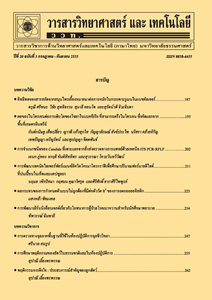การเติบโตและการผลิตรีคอมบิแนนท์เอนไซม์ไฟเตสของยีสต์ Ogataea thermomethanolica
Main Article Content
Abstract
บทคัดย่อ
ระบบการแสดงออกของโปรตีนรีคอมบิแนนต์ในยีสต์ เช่น Saccharomyces cerevisiae และ Pichia pastoris เป็นระบบที่มีประสิทธิภาพสูง อย่างไรก็ตาม หากมีการนำระบบดังกล่าวมาใช้ในการผลิตโปรตีนรีคอม-บิแนนต์ในระดับอุตสาหกรรมภายในประเทศไทยจะมีค่าใช้จ่ายที่สูงมาก เนื่องจากต้องขอรับสิทธิจากต่างประเทศ (license) ดังนั้นการพัฒนายีสต์ Ogataea thermomethanolica ซึ่งเป็นสายพันธุ์ใหม่ที่แยกได้เองภายในประเทศมาประยุกต์เป็นเซลล์เจ้าบ้านเพื่อผลิตโปรตีนรีคอมบิแนนต์จึงเป็นทางเลือกที่น่าสนใจ ซึ่งในงานวิจัยนี้ได้ศึกษาอิทธิพลของพีเอชที่มีผลต่อการเติบโตและการผลิตเอนไซม์ไฟเตสในการเพาะเลี้ยงแบบแบทช์และศึกษาการผลิตเอนไซม์ไฟเตสด้วยกระบวนการเพาะเลี้ยงแบบเฟด-แบทช์เพื่อเพิ่มความหนาแน่นของเซลล์และความเข้มข้นของเอนไซม์ไฟเตส ผลการศึกษาพบว่าพีเอชที่เหมาะสมต่อการเติบโตและการผลิตเอนไซม์ไฟเตส คือ พีเอช 6.0 เนื่องจากให้ค่าความเข้มข้นของเซลล์และค่ากิจกรรมของเอนไซม์ไฟเตสสูงสุดเท่ากับ 14.00±0.21 กรัมต่อลิตร และ 7.83±0.04 หน่วยต่อมิลลิลิตร ตามลำดับ สำหรับการผลิตเอนไซม์ไฟเตสด้วยกระบวนการเพาะเลี้ยงแบบเฟด-แบทช์อาศัยการเติมสับสเทรตด้วยอัตราเอ็กซ์โพเนนเซียล ตามด้วยการเติมด้วยอัตราคงที่เพื่อรักษาระดับของค่าออกซิเจนละลายให้สูงกว่า 20 เปอร์เซ็นต์ ซึ่งในระหว่างการเพาะเลี้ยงไม่พบการสร้างผลิตภัณฑ์รองในรูปของเอทานอลและกรดอะซิติก โดยพบว่าสามารถเพิ่มความเข้มข้นเซลล์และผลผลิตเอนไซม์ไฟเตสเป็น 96.24±2.37กรัมต่อลิตร และ 98.61±1.67 หน่วยต่อมิลลิลิตร และให้อัตราการผลิตเอนไซม์ไฟเตสเชิงปริมาตรสูงถึง 2701.63±45.72 หน่วยต่อลิตร.ชั่วโมง ซึ่งเพิ่มขึ้นประมาณ 3.5 เท่า เมื่อเทียบกับการเพาะเลี้ยงแบบแบทช์ จากผลที่ได้แสดงให้เห็นว่าระบบการแสดงออกของโปรตีนรีคอมบิแนนต์ในยีสต์ O. thermomethanolica เป็นระบบที่มีศักยภาพในการพัฒนาต่อไป
คำสำคัญ : Ogataea thermomethanolica; เอนไซม์ไฟเตส; พีเอชที่เหมาะสม; การเพาะเลี้ยงแบบเฟด-แบทช์
Abstract
Saccharomyces cerevisiae and Pichia pastorisas are known as a well-established and commercially available host for heterologous protein expression systems in yeast. However, high license fees discourage the use of these expression systems for recombinant protein production in Thailand. Therefore, developing a new yeast strain, Ogataea thermomethanolica isolated in Thailand with the suitable properties as a recombinant host would be an alternative solution especially for domestic recombinant protein production. In this study, the impact of pH on growth and recombinant phytase production was investigated in batch cultivation. In addition, fed-batch fermentation was applied to increase cell density as well as phytase concentration. The results showed that pH 6.0 was the optimal pH for both growth and phytase production, since it provided the highest cell concentration and phytase activity of 14.00±0.21 g/L and 7.83±0.04 U/mL, respectively. In fed-batch fermentation, the substrate was initially fed using exponential feed rate and followed by constant feed rate to maintain dissolved oxygen tension (DOT) above 20 % air saturation. The undesired by-products such as ethanol and acetic acid were undetectable during the fermentation period. With this feeding strategy, cell concentration and phytase activity were improved to 96.24±2.37 g/L and98.61±1.67 U/mL, respectively. The volumetric productivity was increased to 2701.63±45.72 U/L.h which was about 3.5 times higher than batch cultivation. This study has revealed the potential of developing O. thermomethanolica expression system as an alternative system for recombinant protein production.
Keywords: Ogataea thermomethanolica; phytase; optimum pH; fed-batch fermentation


